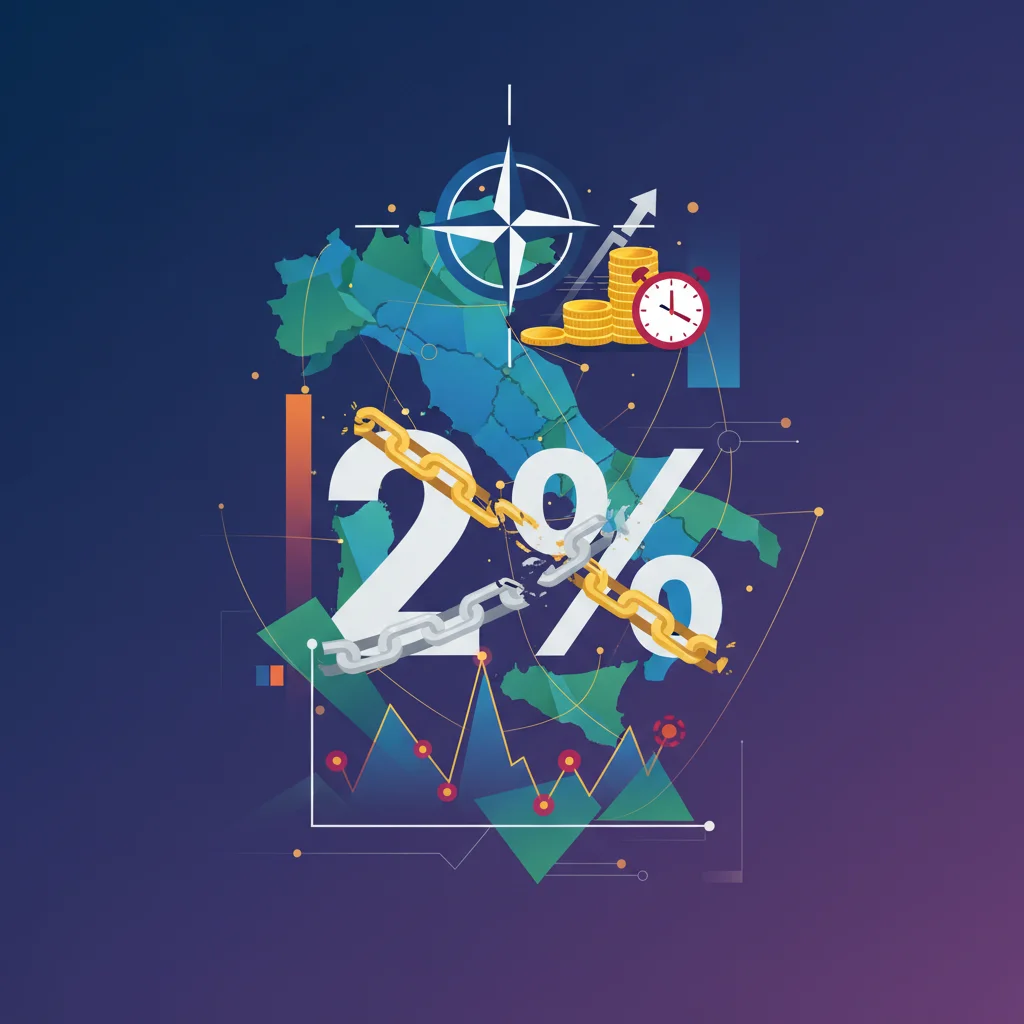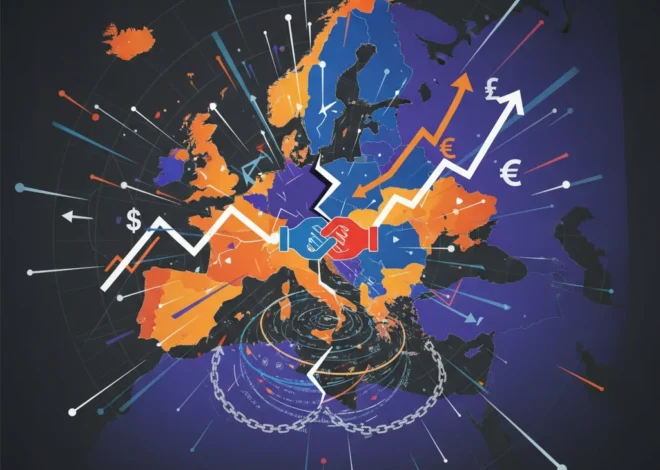
The 2% Dilemma: How NATO’s Mandate Puts Italy’s Fragile Economy on the Front Line
The High Cost of Security: A Ticking Financial Time Bomb?
In the corridors of power from Brussels to Washington, a single number dominates conversations about defense: two percent. This is the guideline for NATO members’ defense spending as a percentage of their Gross Domestic Product (GDP). In an era of escalating geopolitical tensions, this target has transformed from a gentle suggestion into a firm expectation. For nations like the United States or the United Kingdom, it’s a challenging but manageable goal. But for a country like Italy, it represents a monumental fiscal dilemma with profound implications for its economy, the stability of the Eurozone, and the global financial markets.
A recent letter to the Financial Times by Federico Forni poignantly highlighted this very issue, noting the “big effect on states like Italy” that this pressure creates. This isn’t just about balancing budgets; it’s about navigating a treacherous path between national security and economic solvency. As investors, business leaders, and finance professionals, understanding this dynamic is crucial, as the shockwaves from Italy’s fiscal decisions could ripple through the entire global economy, affecting everything from the stock market to the future of banking.
Deconstructing the 2% Mandate: A Goal Forged in Crisis
The 2% defense spending guideline is not a new invention. It was formally agreed upon by NATO allies at the 2014 Wales Summit, in the wake of Russia’s annexation of Crimea. The pledge was a collective recognition that a new era of strategic competition required a renewed commitment to military readiness. For years, many members treated it as a distant aspiration. However, the full-scale invasion of Ukraine in 2022 lit a fire under the alliance, making the 2% figure a hard benchmark of a nation’s commitment to collective defense.
According to the latest NATO estimates for 2024, a record 23 of the 32 member nations are expected to meet or exceed this target, a dramatic increase from just a handful a decade ago. While this signals a strengthened alliance, it also exposes the deep economic fissures within it. For countries with robust growth and manageable public debt, increasing defense budgets is a matter of reprioritization. For Italy, it’s an economic Gordian knot.
The Italian Conundrum: A High-Wire Act of Public Finance
To grasp the severity of Italy’s situation, one must look at its unique economic profile. For decades, the nation has grappled with two persistent challenges: sluggish economic growth and one of the highest public debt-to-GDP ratios in the developed world. As of the end of 2023, Italy’s government debt stood at a staggering 137.3% of its GDP, according to Eurostat. This leaves the government with precious little fiscal headroom.
Every euro allocated to defense is a euro that cannot be spent on other pressing needs, such as:
- Social Services: Funding for healthcare, pensions, and education in an aging population.
- Infrastructure: Modernizing roads, bridges, and digital networks to boost productivity.
- Debt Reduction: Paying down its mountain of debt to lower interest costs and restore market confidence.
- Tax Cuts: Stimulating private sector growth and investment.
Currently, Italy’s defense spending hovers around 1.5% of GDP. Reaching the 2% target would require an additional expenditure of approximately €10 billion annually. In the context of a fragile economy, diverting such a sum could trigger a recession, spook investors, and reignite fears of a sovereign debt crisis reminiscent of the one that nearly tore the Eurozone apart a decade ago. This is the difficult tightrope that Italian policymakers must walk.
Labour's Gamble on a Hardline Asylum Policy: Decoding the Economic and Market Implications
To put this in a global context, here is a comparison of estimated defense expenditures as a percentage of GDP for select NATO countries in 2024.
| NATO Country | Estimated Defense Spending (% of GDP, 2024) | Status vs. 2% Target |
|---|---|---|
| Poland | 4.12% | Exceeds |
| United States | 3.38% | Exceeds |
| United Kingdom | 2.33% | Exceeds |
| Germany | 2.12% | Exceeds |
| France | 1.99% | Below (Marginally) |
| Italy | 1.49% | Below |
| Spain | 1.28% | Below |
Data based on NATO’s June 2024 Compendium. Figures are estimates.
The Economic Ripple Effect: From Rome to Wall Street
If Italy is forced to choose between fiscal prudence and its NATO commitments, the fallout will not be contained within its borders. The interconnected nature of the modern financial system means that a crisis in the Eurozone’s third-largest economy would have global consequences.
1. Sovereign Debt and the Banking System
The most immediate risk lies in the government bond market. If Italy significantly increases its borrowing to fund defense, investors may demand higher interest rates to compensate for the increased risk. This would widen the “spread”—the difference between Italian and ultra-safe German bond yields—which is a key barometer of financial stress in Europe. A spike in borrowing costs would not only make Italy’s debt unsustainable but would also inflict massive losses on the European banking sector, which holds hundreds of billions of euros worth of Italian bonds on its balance sheets. This could trigger a credit crunch, stifling lending and investment across the continent.
2. Stock Market Volatility
A looming fiscal crisis would send shockwaves through the stock market. The Italian FTSE MIB index, heavily weighted with banking and financial stocks, would be particularly vulnerable. However, the impact would be global. Fear of a new Eurozone crisis would drive a “flight to safety,” with investors dumping European equities in favor of U.S. Treasuries or gold. While defense and aerospace stocks might see a short-term boost, the broader market sentiment would be overwhelmingly negative, as the stability of a G7 economy is called into question.
3. The Future of the Euro
At its core, the euro is a political project as much as an economic one. Its stability rests on the perceived solidarity of its members. A crisis centered on Italy, forcing it to choose between its European fiscal obligations (like the Stability and Growth Pact) and its NATO security obligations, would expose deep fault lines within the EU. This could weaken the euro, increase the cost of imports, and fuel inflation, creating a vicious cycle that would be difficult to break.
Navigating the Path Forward: Policy, Economics, and Portfolio Strategy
There are no easy solutions to Italy’s 2% dilemma. Policymakers are exploring several options, including a more gradual increase in spending, pushing for greater efficiency in military procurement, or advocating for common European defense bonds—a move that would pool risk but faces political resistance from more fiscally conservative member states.
For investors and those engaged in trading, this complex environment demands a nuanced approach:
- Macro-Awareness is Key: Pay close attention to European sovereign bond spreads and the political rhetoric coming from Rome and Brussels. These are leading indicators of market stress.
- Sector-Specific Analysis: The “defense premium” is real. Companies involved in aerospace, cybersecurity, and advanced military technology will likely see sustained investment. However, be wary of sectors highly sensitive to economic downturns and rising interest rates, such as banking, real estate, and consumer discretionary goods.
- Diversification and Hedging: The potential for volatility underscores the timeless wisdom of diversification. Holding assets across different geographic regions and currencies can mitigate the impact of a localized European crisis.
Decoding the Market: Why Your Financial Strategy is a Grand Crossword Puzzle
Ultimately, the challenge highlighted by NATO’s spending goals is a microcosm of a larger global trend. The world is moving from an era defined by economic efficiency and globalization to one defined by national security and resilience. This paradigm shift requires a fundamental rewiring of our understanding of risk and value. Italy may be on the front line of this economic battle today, but the principles at stake—balancing security with prosperity, national interest with collective responsibility—are ones that every nation and every investor will have to confront in the years to come.


